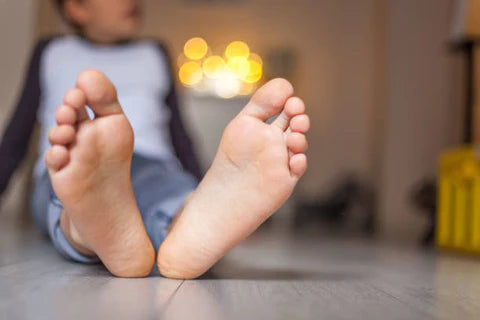Can Kids Get Heel Pain Too?

Heel pain is a condition often associated with excessive activity, age, and stress to the foot. Often thought of as a condition in the adult foot, it may be surprising that children are also susceptible to experiencing this condition.
Youth sports, restrictive shoes, growth spurts, flat feet and obesity are some of the most common contributors to heel pain in children.
Below are the top three types of heel pain seen in children and as well as how to address them as the parent.
Sever’s Disease
Also known as calcaneal apophysitis, Sever’s disease is inflammation of the growth plate at the back of the heel. Occurring most commonly in ages 7 – 15, this condition classically presents as pain on either side of the heel pain and increases with prolonged standing and running. It is typically diagnosed by squeezing the heel on either side to reproduce pain or a burning sensation.
An acute presentation of Sever’s disease is typically treated with rest, ice, heel lifts, and massage to the calf muscles to reduce excess pulling on the growth plate.
Symptoms typically resolve in 6 – 8 weeks.
Achilles Tendinitis
Insertional Achilles tendinitis may present very similar to Sever’s disease with the exception that inflammation and stress are more along the Achilles tendon. It is also not rare to experience a combination of Achilles tendinitis and growth plate inflammation.
Like Sever’s disease, treatment for Achilles tendinitis would include rest, ice, heel lifts, and massage to the calf muscles and to the bottom of the feet to reduce excess pulling on the tendon. Some children may also benefit from the use of a night splint as well as custom orthotics or sensory insoles.
Plantar Fasciitis
The first two causes of heel pain are referred to as posterior heel pain, plantar heel pain can also occur in children with plantar fasciitis being the most common cause. Unlike the first two conditions which are linked to limited ankle mobility or rapid growth spurts, plantar fasciitis is often more related to foot type.
Over-pronation or flat feet is one of the most common contributors to plantar heel pain in children (and adults). Integrating orthotics or sensory insoles for children can greatly reduce plantar fascia stress and the symptoms of plantar heel pain. In addition, plantar foot massage and foot strengthening exercises such as short foot can reduce plantar fasciitis pain and prevent its return once the symptoms resolve.
If your child is experiencing heel pain it is important to consult with their pediatrician or to see your local podiatrist. Like with adult heel pain, the sooner the condition is addressed the faster the recovery.